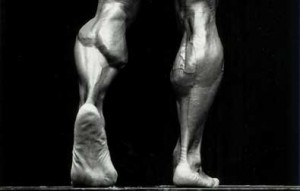The most stubborn and hard to develop body part for most bodybuilders is definitely a pair of diamond shaped calves. Even at the professional level, a great pair of calves is seldom seen on stage.
 I think there are a few reasons why this is the case, especially in today’s bodybuilders as opposed to bodybuilders from the past. Firstly, the top reason that calves elude so many people is simply stated; a lack of effort and an equal lack of understanding just what the calves need to stimulate growth in the area. The majority of trainees tack on a few sloppy half hearted and half @ssed sets at the end of their quad session and then whine about how their calves won’t respond and that it’s just not in the cards for them to ever have a pair of impressive lower legs.
I think there are a few reasons why this is the case, especially in today’s bodybuilders as opposed to bodybuilders from the past. Firstly, the top reason that calves elude so many people is simply stated; a lack of effort and an equal lack of understanding just what the calves need to stimulate growth in the area. The majority of trainees tack on a few sloppy half hearted and half @ssed sets at the end of their quad session and then whine about how their calves won’t respond and that it’s just not in the cards for them to ever have a pair of impressive lower legs.
How calves should be trained
The key is to use a full range of motion, varied rep ranges, stretching between sets, short rest periods, and lots of intensity techniques. You see a ton of guys in the gym using a veritable ton of weight on calf movements, but they are usually doing a half @ssed bobbing kind of motion where the body does most of the moving with no ankle flexion. Go all the way up and all the way down on every rep, and when you can do no more full reps, do half reps until you can’t stand the pain, then do a few more.
Supersets, Drop Sets, and Giant Sets are killer and will help make ’em grow fast. Be intense and work hard, with a full range of motion, and lots of stretching, and they will grow.
More Tips
Another thing is to treat them like any other body part, if you do 12 sets for chest, and tack on only a measly 4 sets for calves, you aren’t working hard enough or smart enough for that matter. I’d do 10-15 sets once a week, and 5-8 sets lighter on another day of the week, depending on your training experience. I have heard many people say that they can’t build their calves because they are a hard dense muscle and no matter what they do the calves do not respond. I think that most people approach calf development in the wrong way. After training for many years, and observing a ton of trainees, in a ton of different gyms, I have come to the conclusion that you have to really shock the calves in almost every training session.
Importance of form and range of motion
I see people doing calves while using the whole weight stack on Standing Calf Raises and just barely moving the weight, with a hopping/bobbing motion of the body. Granted you should train as heavy as possible most times, to stimulate growth, but you must always use a full range of motion, especially on calves, as they are one of the tougher body parts to build for most people, even with correct training. An old friend of mine Barry Krimski, who won several world arm wrestling championships in the mid-late 70’s, once told me I would never be able to build up my calves. Now, I feel my calves are in proportion, and are one of my best body parts. Here are a few of the things I would recommend to get your own “Cows” and a few sample routines I use.
Calf Building Recommendations
- Always get a full range of motion during the exercise.
- Keep the calves guessing by doing different workouts at every training session. The calves adapt to training easier than most muscles.
- Use different intensity techniques, such as Supersets, Drop Sets, Tri-sets.
- Always stretch the calves between sets.
Calf Building Exercises
- Standing Calf Machine
- Seated Calf Machine
- Donkey Calf Raises
- Leg Press Calf Presses
- Standing Calf Machine
My recommendations
I like to set up 4 – 5 machines and go through the sets without stopping, for as many reps as possible per machine. Do a set of each for as many reps as possible, without resting between sets, add a little weight to each machine, stretch them out on a high block of wood between Giant Sets, and go again repeating this for 3-4 cycles. The next day your calves will let you know that they felt the routine.
Another technique is to Superset two movements, such as seated calf raises and standing calf raises.
Do 5 sets of each, adding weight each set. At times you should go lighter, and at other times heavy. Another tactic that I use quite often and find very effective is to do half reps to failure once, until I can no longer perform any more full range reps. This takes the calves into a pain zone that they have never experienced before and extends the set far beyond what you could normal do, which will result in adding more mass to the calves.
Summing It Up
I go as high as 50 reps, at times and as low as 6-8 reps, always in good form with no bouncing. Try some of these suggestions and you may get a couple of cows of your own.
Written By: Tim Wescott










